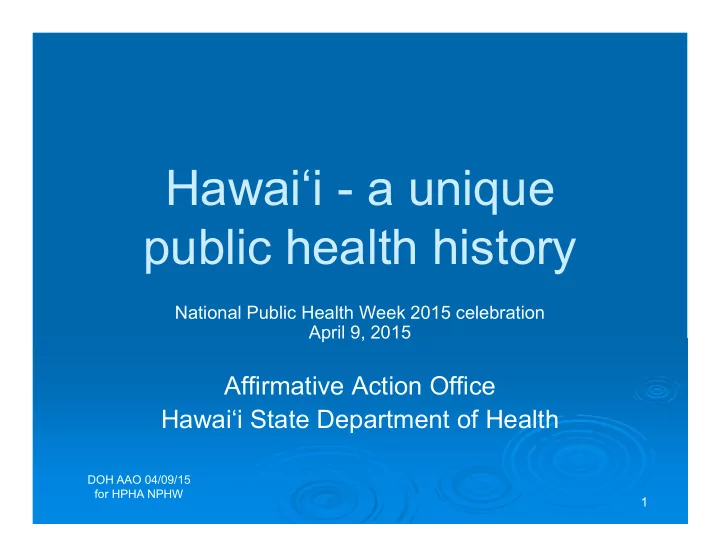

Hawai‘i - a unique public health history National Public Health Week 2015 celebration April 9, 2015 Affirmative Action Office Hawai‘i State Department of Health DOH AAO 04/09/15 for HPHA NPHW 1
Public Health Pre-Contact � The earliest health/public health providers in Hawai‘i - kahuna lapa‘au Ka po‘e kahiko 600 CE settlement to first known other contact. British explorers arrive in 1778 2
Impact of disease on Native Hawaiians � Captain James Cook arrived in 1778 biologic threats - syphilis and gonorrhea � Cholera 1804 (killed 15,000) � Flu, mumps, pertussis, measles 1826 � 1823-1853: Native Hawaiian population decreases by nearly half � Mass depopulation of villages, plantations and urban areas 3
Population Decline of Native Hawaiians Travel to Hawai‘i by Polynesians from 600 CE to first documented other contact in 1778 � 1778: Native Hawaiians estimated at 250,000 by Captain James Cook as robust and healthy � 1831-32: estimated at 130,313 � 1853: estimated at 71,019 � 1872: estimated at 51,531 � 1890: estimated at 40,622 4
Missionary Arrivals: 1820-1849 � Physicians treated westerners, plantation workers and others. � Little western medical training and little PH knowledge - cupping, bleeding, simple surgical procedures, caster oil, tooth-pulling and purges � Contagion concepts not well understood � Doctors’ shops - often sold other poisons, perfume, writing materials and other sundries 5
Honolulu, early 1800’s 6
Hawai‘i’s Board of Health (“An Act relating to the Public Health”) � Oldest state DOH in U.S. Kingdom-wide by 5/16/1853 by Kamehameha III (Kauikeaouli) � King appointed three to serve without pay to serve entire kingdom (Gerrit Judd, Thomas Rooke, William Parke) � Impetus due to smallpox threat - ships quarantined up to 42 days - also led to vaccination efforts, day of prayer on 6/14/1853 � Hospital/quarantine station established for smallpox (present-day Kapi‘olani Park) 7
8
Smallpox in Hawai‘i � 1825: Vaccination attempts by Dr. Abraham Blatchley � 1839: Dr. Thomas Rooke and others work to vaccinate 8,000 to 10,000 � Smallpox worldwide threat - reaches Honolulu in 1836, 1841 and 1853 � 1853: houses became small hospitals and whole families died without care - afraid to go to facilities, feared death � 1853: A sand island off Honolulu provided by Prince Lot Kapuāiwa (later Kamehameha V) for quarantine � ? spread by via infected clothing from San Francisco 9
Hawai‘i’s Leaders in Public Health � Hawai‘i DOH traces its origin to 1850 under Kamehameha III (Kauikeaouli) � The Queen’s Hospital established in 1859 by Kamehameha IV (Alexander Liholiho) & Queen Emma � Hawai‘i’s 1st medical society started by Kamehameha IV and community physicians 10
Repopulation Efforts for Hawai‘i � 1850: passage of “Act for the Government of Masters and Servants.” 1870 Reciprocity treaty with US. � 1852-1887: 57,000 Chinese to work sugar plantations � 1877-1896:18,000 Portuguese immigrated with families � 1885-1924: 200,000 Japanese immigrated with families � 1906-1934: 113,000 Filipinos begin influx as Nationals. � Sugar planters hired physicians to care for workers and families - developed plantation care system � Cultural and social care factors evident in plantation care system still visible today (“cradle to grave” medicine) 11
12
Hansen’s Disease (Leprosy) in Hawai‘i � Also called Ma‘i Pake and Ma‘i Ho‘oka‘awale ‘Ohana � First thought found here circa 1830 � Quarantine in Kalihikai west of Honolulu in 1865 and in Kaka‘ako in 1881 � Leprosy Colony on Moloka‘i (Kalaupapa) in 1866 � Father (Saint) Damien at Kalaupapa from 1873 -1889. Mother (Saint) Marianne who arrived at Kalihi 1883 and at Kalaupapa 1888 � Disproportionately affected Native Hawaiians and poor immigrants 13
14
Bubonic Plague in Hawai‘i � Diagnosed in Chinatown by Dr. Sun Chin in patient Yon Chong in 1899 (12/9/1899) � Case confirmed with others who informed Board � Military quarantine of Chinatown and port of Honolulu closed � Burning of Chinatown 1900, a political and PH blunder (12/31/1899 to 1/20/1900) � Plague blunted 1900 (3/31/1900) – 61 dead � Epidemic control led by Board of Health 15
16
Effects on Population Health & PH � By 1900, rural hospitals established on or near plantations � 1906 First PHNs employed by Palama Settlement for TB control � 1901 to 1917: TB sanatoriums established at Le‘ahi, Kula, Pu‘umaile, and Kapa‘a � 1920: unions and plantations – better wages, housing, health care, MCH and other welfare programs improved � 1923: Board of Health dairy campaign to make milk safer – baby feeding clinic established at Queen’s 17
18
Effects on Population Health & PH � PH nursing and health centers started in 1923, to improve MCH, especially on neighbor islands � 1930’s: systemic improvements made to plantation housing, sanitation, and health centers � Epidemiological data gathered regularly - improved diets, medications and immunizations reduced mortality and morbidity rates � By 1956, most infants were born in hospitals and delivered by physicians 19
20
Some mileposts PH and personal � 1940’s-WWII. Dengue fever. Sulfones treat Hansen’s Disease. HPHA founded � 1950’s-a century of PH. Statehood. � 1960’s-isolation for Hansen’s Disease ended. Board of Health re-organized � 1970’s-abortion liberalized. Clean Air/Clean Water. Pre-Paid Health Care Act 21
Recent past and present Prior to, but especially after 9/11 and the anthrax mail threat, public health emergency preparedness and response and public’s attention increased to multiple threats, hazards, and emergencies. 22
Some mileposts PH and personal � 1980’s-heptachlor. VOG. AIDS. SHIP reduces uninsured to 3%. OHH � 1990’s-Iniki. Recession and cuts. NPHPSP. DOJ, Felix and Makin suits � 2000’s-bioterrorism threat. Core Competencies. TSP � 2010’s-revised strategic plan. accreditation What is your part in PH of the past and future? 23
Public Health everyone’s kuleana +YOU DOH AAO 04/09/15 for HPHA NPHW 24
Recommend
More recommend